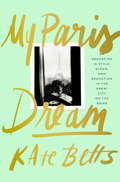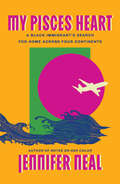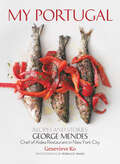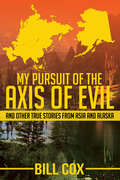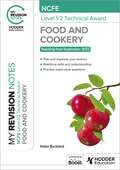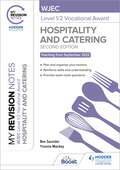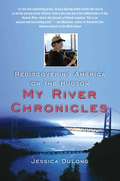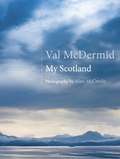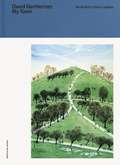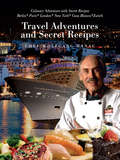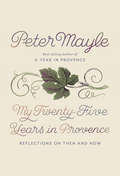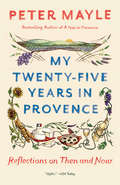- Table View
- List View
My Paris Dream: An Education in Style, Slang, and Seduction in the Great City on the Seine
by Kate BettsA charming and insightful memoir about coming of age as a fashion journalist in 1980s Paris, by former Vogue and Harper's Bazaar editor Kate Betts, the author of Everyday Icon: Michelle Obama and the Power of Style"You can always come back," my mother said. "Just go." As a young woman, Kate Betts nursed a dream of striking out on her own in a faraway place and becoming a glamorous foreign correspondent. After college--and not without trepidation--she took off for Paris, renting a room in the apartment of a young BCBG (bon chic, bon genre) family and throwing herself into the local culture. She was determined to master French slang, style, and savoir faire, and to find a job that would give her a reason to stay.After a series of dues-paying jobs that seemed only to reinforce her outsider status, Kate's hard work and willingness to take on any assignment paid off: Her writing and intrepid forays into la France Profonde--true France--caught the eye of John Fairchild, the mercurial fashion arbiter and publisher of Women's Wear Daily, the industry's bible. Kate's earliest assignments--investigating the mineral water preferred by high society, chasing after a costumed band of wild boar hunters through the forests of Brittany--were a rough apprenticeship, but she was rewarded for her efforts and was initiated into the elite ranks of Mr. Fairchild's trusted few who sat beside him in the front row and at private previews in the ateliers of the gods of French fashion. From a woozy yet mesmerizing Yves Saint Laurent and the mischievous and commanding Karl Lagerfeld to the riotous, brilliant young guns who were rewriting all the rules--Martin Margiela, Helmut Lang, John Galliano--Betts gives us a view of what it was like to be an American girl, learning about herself, falling in love, and finding her tribe.Kate Betts's captivating memoir brings to life the enchantment of France--from the nightclubs of 1980s Paris where she learned to dance Le Rock, to the lavender fields of Provence and the grand spectacle of the Cour Carrée--and magically re-creates that moment in life when a young woman discovers who she's meant to be. Praise for My Paris Dream "[Betts] shares her coming-of-age in a self-assured book that should be given to every college senior with a Doisneau poster (or Chanel ad) on her wall. . . . Those of us who've been there and back will find it entertaining and sneakily poignant reading on the flight to Charles de Gaulle."--The New York Times Book Review "Even if your summer travel plans don't include a stroll on the Champs Élysées, you'll always have My Paris Dream. . . . As light and refreshing as an ice cream cone from the legendary Berthillon, My Paris Dream evokes the sights, sounds, smells and styles of 1980s Paris."--USA Today"An amazing story of a young woman in Paris trying to break into the fashion business as a journalist, My Paris Dream is a fun read. Kate Betts's trajectory of inventing herself is uniquely her own but incredibly universal as well."--Sophia Amoruso, author of #GIRLBOSS "Kate Betts's story brought me back to my own young self and the journey I made--in my case, from a small town in Illinois to New York City. She's captured that youthful fearlessness and the romantic impulse we have to strike out and find ourselves."--Cindy CrawfordFrom the Hardcover edition.
My Paris Kitchen: Recipes and Stories
by David LebovitzA collection of stories and 100 sweet and savory French-inspired recipes from popular food blogger David Lebovitz, reflecting the way modern Parisians eat today and featuring lush photography taken around Paris and in David's Parisian kitchen.It's been ten years since David Lebovitz packed up his most treasured cookbooks, a well-worn cast-iron skillet, and his laptop and moved to Paris. In that time, the culinary culture of France has shifted as a new generation of chefs and home cooks--most notably in Paris--incorporates ingredients and techniques from around the world into traditional French dishes. In My Paris Kitchen, David remasters the classics, introduces lesser-known fare, and presents 100 sweet and savory recipes that reflect the way modern Parisians eat today. You'll find Soupe à l'oignon, Cassoulet, Coq au vin, and Croque-monsieur, as well as Smoky barbecue-style pork, Lamb shank tagine, Dukkah-roasted cauliflower, Salt cod fritters with tartar sauce, and Wheat berry salad with radicchio, root vegetables, and pomegranate. And of course, there's dessert: Warm chocolate cake with salted butter caramel sauce, Duck fat cookies, Bay leaf poundcake with orange glaze, French cheesecake...and the list goes on. David also shares stories told with his trademark wit and humor, and lush photography taken on location around Paris and in David's kitchen reveals the quirks, trials, beauty, and joys of life in the culinary capital of the world.
My Pisces Heart: A Black Immigrant's Search for Home Across Four Continents
by Jennifer NealWith heart, humor, and razor-sharp observation, this intimate and incisive memoir traces the journey of a Black, queer woman as she searches the world for a place of security and acceptance to call homeI&’ve never seen home as a permanent concept; it is an image crafted from untempered glass that threatens to shatter with lack of care.Jennifer Neal was born in the United States to a family that moved continuously for their own survival and well-being—from the Great Migration to the twenty-first century. As an adult, she has continued to travel the world as a Black queer woman, across two decades and four countries—from Japan to the US and then Australia to Germany, where she has settled for now.Throughout her moves, Neal threads her personal story of immigration with local Black histories and racial politics to provide context for her own experiences. The result is both a crucial examination of how racism plays a foundational role in modern-day immigration systems and a tender tribute to immigrants and their stories.An unwavering interrogation of colonialism and policy, love and loss, hypocrisy and resistance, My Pisces Heart demands meaningful conversation about not only the ways in which we live with our histories, but also how they live through us—urging an honest dialogue on why the West continues to grapple with its past and visualize its future.
My Portugal: Recipes and Stories
by George Mendes&“With crisp, toothsome images of the dishes and postcard-worthy shots of Portugal, Mendes&’s collection is an inspired, loving tribute to the country.&” —Publishers Weekly (starred review) Chef-restaurateur George Mendes introduces us to the world of Portuguese cuisine, offering 125 mouthwatering recipes that showcase the wide range of dishes that come from this coastal country. The collection balances Mendes&’s recipes from his Michelin-starred New York restaurant, Aldea, such as his signature Duck Rice and Garlic Seared Shrimp with his takes on classic Portuguese dishes such as Salt Cod, Potato, and Egg Casserole; Mozambique Shrimp and Okra with Piri Piri; Eggs Baked with Peas, Linguiça, and Bacon; Butter Cookies; and more. His stories illustrate the wealth of culinary resources in Portugal—fresh seafood, savory meats, and crisp vegetables. With delicious recipes and stunning photographs of the country, My Portugal takes us on an unforgettable journey. &“His cuisine is filled with the intensely satisfying flavors of a casual Portuguese feast—updated with a beautifully modern presentation and technique du jour&”—Daniel Boulud
My Pursuit of the Axis of Evil: And Other True Stories From Asia and Alaska
by Bill CoxMy Pursuit of the Axis of Evil is about meetings and adventures with interesting people in Asia and Alaska. I followed the advice of a long-ago traveler named Pythagoras, who admonished us to check your prejudices at every port of entry." As a result, I mostly traveled solo, merged with the locals, and got to see, experience, and understand things that would not have been otherwise possible. Plus, the locals can keep you out of trouble and get you out of trouble if you get into it! In Alaska, I sought out native elders and others in the far corners of this enormous state, street people, and the many interesting and famous people visiting or passing through. And high-level politicians—often at the opposite end of the political and social issues spectrum than me. I learned a lot, made new friends, and often got to see things from a different perspective. Encounters were overwhelmingly positive, and it is these people to whom I dedicate My Pursuit of the Axis of Evil. I commend you for your natural curiosity and desire to go out into the world and see for yourself. Pursuit of the Axis of Evil is a great primer on how to engage and interact with the incredible variety of people we meet on international travel - people that appear on the surface to be very different from you and me. Robert DeLaurentis, Polar and Equitorial Circumnavigator/Citizen of the World. "
My Revision Notes: NCFE Level 1/2 Technical Award in Food and Cookery
by Helen BucklandSet students on track to achieve the best grade possible with My Revision Notes. Our clear and concise approach to revision will help students learn, practise and apply their skills and understanding. Coverage of key content is combined with practical study tips and effective revision strategies to create a guide that can be relied on to build both knowledge and confidence. My Revision Notes for NCFE Level 1/2 Technical Award in Food and Cookery will help students: - Consolidate knowledge with clear, concise and relevant content coverage, based on what examiners are looking for - Extend understanding with our regular 'Now Test Yourself', tasks and answers - Improve technique through our increased exam support, including exam-style practice questions, expert tips and examples of typical mistakes to avoid - Identify key connections between topics and subjects with our 'Making Links' focus and further ideas for follow-up and revision activities - Plan and manage a successful revision programme with our topic-by-topic planner, new skills checklist and exam breakdown features, user-friendly definitions and glossary
My Revision Notes: NCFE Level 1/2 Technical Award in Food and Cookery
by Helen BucklandSet students on track to achieve the best grade possible with My Revision Notes. Our clear and concise approach to revision will help students learn, practise and apply their skills and understanding. Coverage of key content is combined with practical study tips and effective revision strategies to create a guide that can be relied on to build both knowledge and confidence. My Revision Notes for NCFE Level 1/2 Technical Award in Food and Cookery will help students: - Consolidate knowledge with clear, concise and relevant content coverage, based on what examiners are looking for - Extend understanding with our regular 'Now Test Yourself', tasks and answers - Improve technique through our increased exam support, including exam-style practice questions, expert tips and examples of typical mistakes to avoid - Identify key connections between topics and subjects with our 'Making Links' focus and further ideas for follow-up and revision activities - Plan and manage a successful revision programme with our topic-by-topic planner, new skills checklist and exam breakdown features, user-friendly definitions and glossary
My Revision Notes: WJEC Level 1/2 Vocational Award in Hospitality and Catering, Second Edition
by Yvonne Mackey Bev SaunderTarget exam success with My Revision Notes. Our updated approach to revision will help youlearn, practise and apply your skills and understanding. Coverage of key content is combinedwith practical study tips and effective revision strategies to create a guide you can rely on tobuild both knowledge and confidence.My Revision Notes: WJEC Level 1/2 Vocational Award in Hospitality and Catering helps all students:- Develop subject knowledge by making links between topics for more in-depth exam answers- Plan and manage revision with our topic-by-topic planner and exam breakdown introduction- Build quick recall with bullet-pointed summaries at the end of each chapter- Understand key terms needed for the exam with user-friendly definitions and a glossary- Avoid common mistakes and enhance exam answers with exam tips- Improve subject-specific skills with an exam skills checkbox at the end of each chapter- Practise and apply skills and knowledge with Exam-style questions and frequent Now test yourself questions, and answer guidance online
My Revision Notes: WJEC Level 1/2 Vocational Award in Hospitality and Catering, Second Edition
by Yvonne Mackey Bev SaunderTarget exam success with My Revision Notes. Our updated approach to revision will help youlearn, practise and apply your skills and understanding. Coverage of key content is combinedwith practical study tips and effective revision strategies to create a guide you can rely on tobuild both knowledge and confidence.My Revision Notes: WJEC Level 1/2 Vocational Award in Hospitality and Catering helps all students:- Develop subject knowledge by making links between topics for more in-depth exam answers- Plan and manage revision with our topic-by-topic planner and exam breakdown introduction- Build quick recall with bullet-pointed summaries at the end of each chapter- Understand key terms needed for the exam with user-friendly definitions and a glossary- Avoid common mistakes and enhance exam answers with exam tips- Improve subject-specific skills with an exam skills checkbox at the end of each chapter- Practise and apply skills and knowledge with Exam-style questions and frequent Now test yourself questions, and answer guidance online
My River Chronicles: Rediscovering the Work That Built America - A Personal and Historical Journey
by Jessica DulongFrom dot-com desk job to the hull of an antique fireboat, this unique memoir tells how DuLong discovered the meaning of work on America's first river.
My Road Trip to the Pretty Girl Capital of the World
by Brian YanskyIn 1979 when his life in Mansfield, Iowa, seems to fall apart, seventeen-year-old Simon takes his father's car and sets out for Texas, looking for his birth parents and picking up a man claiming to be Elvis, two bums, and an abused young wife along the way. My Road Trip to the Pretty Girl Capital of the World is a novel that perfectly captures the flavor of the post-hippie grit, post-slacker cool, and weird-techno wealth of Austin.
My Roman History: A Memoir
by Alizah Holstein&“A lyrical and moving exploration of the ways in which the heart governs even the pursuit of a life of the mind, this is a book for anyone who has ever loved Rome, as well as anyone who shares the experience of having found, in an unfamiliar history, their own unexpected home.&” —Rebecca Mead, author of My Life in Middlemarch and Home/LandIn this exquisite and profound memoir, a medieval historian traces her lifelong obsession with Rome and the encounters with the city&’s past and present that became fulcrum points in her lifeFrom the time she first felt called to its gates as a high school student fascinated by Dante and Italian thanks to a life-changing teacher, Rome has been a fixed star around which Alizah Holstein&’s life has rotated—despite the fact that she bears no Italian heritage, and has never lived there long enough to call it home. In this kaleidoscopic yet intimate memoir, her shifting relationship to a vibrant city layered with human history becomes a lens on why we look to the past, on the mysteries of affinity and desire, and on what it means to grow up. Holstein weaves the stories of Romans past and present, and encounters with the city of historical figures from Petrarch to Freud, into the narrative of her evolution from a curious student abuzz with the thrill of discovery, to a lonely researcher in a city to which she feels she belongs despite knowing no one, to an ambitious young historian struggling to find her place in the halls of academia. Following a trail of memories—that first taste of a tartufo cioccolato in Piazza Navona, the ancient walls of the Via Appia blurring from the back of a motorcycle, the smudge of ink on a manuscript left by a scribe's hand over seven hundred years before—she explores what it means to be romana, Roman—and to find solace and self-knowledge in the presence of the past.An enveloping, original, and deeply resonant account, set against one of the world's most beguiling cities, of the unexpected things that give our lives meaning, My Roman History is a profound depiction of the winding path to self-realization, which—much like history itself—is mysterious, captivating, and ever-unfolding.
My Scotland
by Val McDermid'I love stories. My life has been book-ended and bookmarked by hearing them, reading them and telling them. In my mind's eye, I can see where each of these stories unfolds . . .'__________In MY SCOTLAND, Sunday Times bestselling author Val McDermid takes readers to the landscapes she has known all her life, and the places where her stories and characters reside.Accompanied by over 100 stunning photographs, this remarkable book uncovers Val's own Scotland in all its glory - from the iconic Isle of Skye to the majestic streets of Edinburgh; from the undiscovered hideaways of the Highlands to the wild and untamed Jura.__________Featuring excerpts from Val McDermid's bestselling novels and charting Karen Pirie's Fife to Lindsay Gordon's Glasgow, MY SCOTLAND is an unforgettable and uniquely personal journey.
My Scotland
by Val McDermid'I love stories. My life has been book-ended and bookmarked by hearing them, reading them and telling them. In my mind's eye, I can see where each of these stories unfolds . . .'In MY SCOTLAND, number one bestselling author Val McDermid takes readers to the landscapes she has known all her life, and the places where her stories and characters reside.Accompanied by over 100 stunning photographs, this remarkable book uncovers Val's own Scotland in all its glory - from the iconic Isle of Skye to the majestic streets of Edinburgh; from the undiscovered hideaways of the Highlands to the wild and untamed Jura.Featuring excerpts from Val McDermid's bestselling novels and charting Karen Pirie's Fife to Lindsay Gordon's Glasgow, MY SCOTLAND is an unforgettable and uniquely personal journey.
My Secret Guide to Paris (Scholastic Press Novels)
by Lisa SchroederFrom the author of the Charmed Life and It’s Raining Cupcakes series comes a novel of family, friends, and a French adventure you’ll never forget!Nora loves everything about Paris, from the Eiffel Tower to chocolat chaud. Of course, she’s never actually been there—she’s only visited through her Grandma Sylvia’s stories. And just when they’ve finally planned a trip together, Grandma Sylvia is suddenly gone, taking Nora’s dreams with her.Nora is crushed. She misses her grandmother terribly, but she still wants to see the city they both loved. So when Nora finds letters and a Paris treasure map among her Grandma Sylvia’s things, she dares to dream again . . . She’s not sure what her grandma wants her to find, but Nora knows there are wonderful surprises waiting for her in Paris. And maybe, amongst the croissants and macarons, she’ll even find a way to heal her broken heart.“This love letter to the City of Light will have readers believing that everything’s better in Paris. Schroeder lets the city’s romance shine in a thoughtful story, laced with mystery and French vocabulary, about losing family and gaining individuality in a place where curiosity can bloom.” —Publishers Weekly“A light and frothy Parisian adventure with hints of emotional heft.” —School Library Journal“Nora’s hopeful, openhearted character is beautifully depicted.” —Kirkus Reviews
My Secret History
by Paul Theroux"Theroux's best novel in years."CHICAGO TRIBUNEMY SECRET HISTORY is Paul Theroux's tour de force. It is the story of Andre Parent, a writer, a world traveler, a lover of every kind of woman he chances to meet in a life as varied as a man can lead. From his days as an altar boy, to his job as a teenaged lifeguard, and then as a youth caught between the attentions of a beautiful young student and an amorous older woman. And as the boy becomes a man he turns his attention to writing, which brings him fame, and a wife, who may finally bring him to know himself. But not before he sets up his most dangerous secret life, one that any man might envy, but that could cost Andre Parent the delicate balance that makes him who he is....From the Paperback edition.
My Tiny Atlas: Our World Through Your Eyes
by Emily NathanA wanderlust-inspiring and transporting collection of photos from some of the world's most astounding places, organized thematically—vistas, sunrises and sunsets, city streets and urban life, tropical jungles, dramatic architectural facades, food stalls and restaurants, and more—from the premier online curator of travel photography.As much an armchair travel companion as a guide to planning your next trip, My Tiny Atlas contains more than 200 lush, surprising, and stunning photos, along with stories about far-flung locales and tips for experiencing a new location like a local. From Tiny Atlas Quarterly—one of the most trusted sources for authentic, unusual, and inspiring travel photography—this book takes you to every continent and all corners of the world, from Paris, San Francisco, London, and Buenos Aires to the Arctic Circle, Tanzania, Tahiti, and Mongolia. My Tiny Atlas visually explores new destinations with an intimate, insider's view—not of the usual monuments and tourist attractions, but of the real people, mouth-watering food, verdant flora, bustling streets, wild animals, epic views, lazy rivers, architectural gems, and other details that make you feel what it's like to truly be in another place, whether or not you ever leave home.
My Town: An Artist's Life in London
by David GentlemanDavid Gentleman has lived in London for almost seventy years, most of it on the same street. This book is a record of a lifetime spent observing, drawing and getting to know the city, bringing together work from across his whole career, from his earliest sketches to watercolours painted just a few months ago.Here is London as it was, and as it is today: the Thames, Hampstead Heath; the streets, canals, markets and people of his home of Camden Town; and at the heart of it all, his studio and the tools of his work. Accompanied by reflections on the process of drawing and personal thoughts on the ever-changing city, this is a celebration of London, and the joy of noticing, looking and capturing the world.'David has spent a lifetime depicting with wit and affection a London he has made his own' Alan Bennett 'He delivers a poetry of exultant concentration ... The surface fusion of the sensuous and the sharply modern is echoed by Gentleman's imagery' Guardian 'The artist and illustrator has been responsible for some of the most-seen public artworks in this country' The Times 'Perhaps the last of the great polymath designer-painters' Camden New Journal
My Travel Adventures and Secret Recipes: Culinary Adventures With Secret Recipes
by Chef HanauCHEF WOLFGANG HANAU, born and educated in Eastern Europe, learned to love good cooking from an early age, so it was only natural that he’d go on to become a world-renowned chef. What isn’t so natural, however, is his willingness to share the secret recipes he’s learned over a decades-long career at some of the world’s most exclusive restaurants, luxury hotels, and resorts. In this memoir/recipe book, he revels in dishes with a French fl air, Bavarian specialties from Munich’s Oktoberfest, Switzerland’s renowned international cuisine, and dishes from the many great places he’s practiced his craft. You’ll laugh and smile as he enjoys camelback rides in the Sahara desert, cruises on luxury ocean liners, and meets celebrities at culinary destinations that offer sun, fun, and escapes from the ordinary. Along the way, he shares recipes that will impress your relatives and friends, including German Warm Potato Salad, the Allenstein Bbq Recipe, Bearnaise Sauce, Rainforest Acai Berry Cookies, Amstel Light Portobello Gorgonzola Burger, Golden Apple Cheddar Pancakes, Apple Jam-Filled Cookies, and Apricot-Glazed Mushrooms over Mixed Baby Greens. There’s an exciting story and a tasty dish for everyone in this book of secret recipes and travel adventures. Chef Wolfgang Hanau, a native of Bavaria, graduated with a bachelor’s degree in culinary arts from the Culinary Institute in Munich. He has worked in Switzerland, Paris, and London and has practiced his craft at many popular hotels and resorts. He lives with his wife, Diana, in West Palm Beach, Florida.
My Twenty-Five Years in Provence: Reflections on Then and Now
by Peter MayleThe beloved author Peter Mayle, champion of all things Provence, here in a final volume of all-new writing, offers vivid recollections from his twenty-five years in the South of France: lessons learned, culinary delights enjoyed, and changes observed.Twenty-five years ago, Peter Mayle and his wife, Jennie, were rained out of a planned two weeks on the Côte d'Azur. In search of sunlight, they set off for Aix-en-Provence; enchanted by the world and life they found there, they soon decided to uproot their lives in England and settle in Provence. They have never looked back. As Mayle tells us, a cup of café might now cost three euros--but that price still buys you a front-row seat to the charming and indelible parade of village life. After the coffee, you might drive to see a lavender field that has bloomed every year for centuries, or stroll through the ancient history that coexists alongside Marseille's metropolitan bustle. Modern life may have seeped into sleepy Provence, but its magic remains.With his signature warmth, wit, and humor--and twenty-five years of experience--Peter Mayle is a one-of-a-kind guide to the continuing appeal of Provence. This thoughtful, vivid exploration of life well-lived, à la Provence, will charm longtime fans and a new generation of readers alike.
My Twenty-Five Years in Provence: Reflections on Then and Now
by Peter MayleThe beloved author Peter Mayle, champion of all things Provence, here in a final volume of all new writing, offers vivid recollections from his twenty-five years in the South of France--lessons learned, culinary delights enjoyed, and changes observed.Twenty-five years ago, Peter Mayle and his wife, Jennie, were rained out of a planned two weeks on the Côte d'Azur. In search of sunlight, they set off for Aix-en-Provence; enchanted by the world and life they found there, they soon decided to uproot their lives in England and settle in Provence. They have never looked back. As Mayle tells us, a cup of café might now cost three euros--but that price still buys you a front-row seat to the charming and indelible parade of village life. After the coffee, you might drive to see a lavender field that has bloomed every year for centuries, or stroll through the ancient history that coexists alongside Marseille's metropolitan bustle. Modern life may have seeped into sleepy Provence, but its magic remains.With his signature warmth, wit, and humor--and twenty-five years of experience--Peter Mayle is a one-of-a-kind guide to the continuing appeal of Provence. This thoughtful, vivid exploration of life well-lived, à la Provence, will charm longtime fans and a new generation of readers alike.
My Usual Table: A Life in Restaurants
by Colman AndrewsA vivid memoir and an “appealing” love letter to great restaurants by a James Beard Award winner and founding editor of Saveur (Los Angeles Times).For Colman Andrews, restaurants have been his playground, his theater, his university, his church, his refuge. The establishments he has loved have not only influenced culinary trends at home and abroad, but represent the changing history and culture of food in America and Western Europe. From his usual table, he has watched the growth of Nouvelle Cuisine and fusion cuisine; the organic and locavore movements; nose-to-tail eating; and so-called “molecular gastronomy.”In My Usual Table, Andrews interweaves his own story—from growing up in the sunset years of Hollywood’s golden age and dining at Chasen’s and Trader Vic’s to traveling the world in pursuit of great food—with tales of the restaurants, chefs, and restaurateurs who are emblematic of the revolutions great and small that have forever changed the way we eat, cook, and think about food.“In the hands of a less adept writer, Andrews’ narratives of movie stars cavorting in their favorite restaurant haunts or dining at his parents’ house might seem mere name-dropping, but his respect and affection for these celebrities make for enjoyable storytelling.” —Booklist“A compelling writer . . . his descriptions of restaurants past will lead readers who chronicle their own days in Instagrammed meals on an adventure in armchair time travel.” —San Francisco Chronicle
My Venice: And Other Essays
by Donna Leon“Donna Leon has won a huge number of passionate fans and a tremendous amount of critical acclaim for her international bestselling mystery series featuring Venetian Commissario Guido Brunetti. These accolades have built up not just for her intricate plots and gripping narratives, but for her insight into the culture, politics, family-life, and history of Venice, one of the world’s most-treasured cities, and Leon’s home for over thirty years. Readers love how Leon opens the doors to a private Venice, beyond the reach of the millions of international tourists who delight in the city's canals, food, and art every year. “My Venice and Other Essays” will be a treat for Leon's many fans, as well as for lovers of Italy and La Serenissima. For many years, Leon, who is a perennial #1 bestseller in Germany, has written essays for European publications. Collected here are the best of these: over fifty funny, charming, passionate, and insightful essays that range from battles over garbage in the canals to the troubles with rehabbing Venetian real estate. She shares episodes from her life in Venice, explores her love of opera, and recounts tales from in and around her country house in the mountains. With pointed observations and humor, she also explores her family history and former life in New Jersey, and the idea of the Italian man.
My Vermont Table (Six) Seasons: Recipes For All (six) Seasons
by Gesine Bullock-PradoVermont—arguably the OG farm-to-table state—is celebrated through 100+ recipes and stories from celebrated pastry chef Gesine Bullock-Prado. When Gesine Bullock-Prado left her Hollywood life in 2004 and moved to Vermont, she fell in love with the Green Mountain State’s flavors and six unique seasons. Spring, summer, fall, and winter all claim their place at this table, but a true Vermonter holds extra space for maple-forward mud season—that time of year before spring when thawing ice makes way for mucky roads—and stick season, a notable period of bare trees and gourds galore prior to winter. In My Vermont Table, Bullock-Prado takes readers on a sweet and savory journey through each of these special seasons. Recipes like Blackberry Cornmeal Cake, Vermont Cheddar Soup, Shaved Asparagus Toasts, and Maple Pulled Pork Sliders utilize local produce, dairy, wine, and flour. And quintessential Vermont flavors are updated with ingredients and spices from Bullock-Prado’s own backyard. With stunning photography, Vermonters and visitors alike will revel in a seat at this table.
